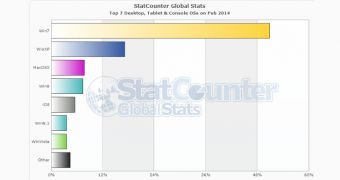Microsoft has invested millions of dollars to make Windows 8 and Windows 8.1 successful, but statistics provided every month by third-party research firms across the world point to only minor market share gains.
Figures posted by StatCounter for the month of February 2014 indicate that Windows 7 is now powering more than half of desktop computers worldwide, while Windows 8 and Windows 8.1 recorded only a slight increase in the last month.
At this point, Windows 7 has a market share of 50.9 percent and figures are very likely to grow even bigger in the next couple of months as more Windows XP users decide to migrate. Unsurprisingly, with so many people disappointed with Windows 8 and 8.1, the majority still choose Windows 7 as the next destination, at least until Microsoft comes up with a better OS version.
Windows XP lost only a few users in February and now has a market share of 17.07 percent, which is just another indication that Microsoft’s ancient OS version won’t be dead by April. Redmond will officially stop providing updates and security patches for Windows XP on April 8, so you have less than 40 days to migrate if you’re still running this particular OS version.
Mac OS X is far behind but still holds the third position in the desktop OS chart with 7.74 percent. Unsurprisingly, Windows 8 comes next with 7.36 percent and, if the same ascending trend is maintained, Microsoft’s modern OS should overtake Apple’s as soon as next month.
Windows 8.1 is only the sixth name on the list with 3.55 percent, but this means that Microsoft’s modern operating systems (Windows 8 and Windows 8.1) are holding an overall market share of 10.91 percent, enough to become the third platform in the charts.
Linux is still missing from the stats, which means that, although so many people said that they are migrating from Windows XP to the open-source platform, its market share remains low.
Even though so many people move to Windows 7 instead of Windows 8.1, Microsoft must be pleased that the transition from Windows XP continues, as it really needs users to dump the old OS version and upgrade hardware as soon as possible.
Hardware upgrades are essential for the future of Microsoft’s Windows operating system, as both Windows 8 and 8.1 come with higher system requirements, which means that old machines, such as those capable of running Windows XP, won’t be able to install the modern platform, and thus adoption could remain low.

 14 DAY TRIAL //
14 DAY TRIAL //